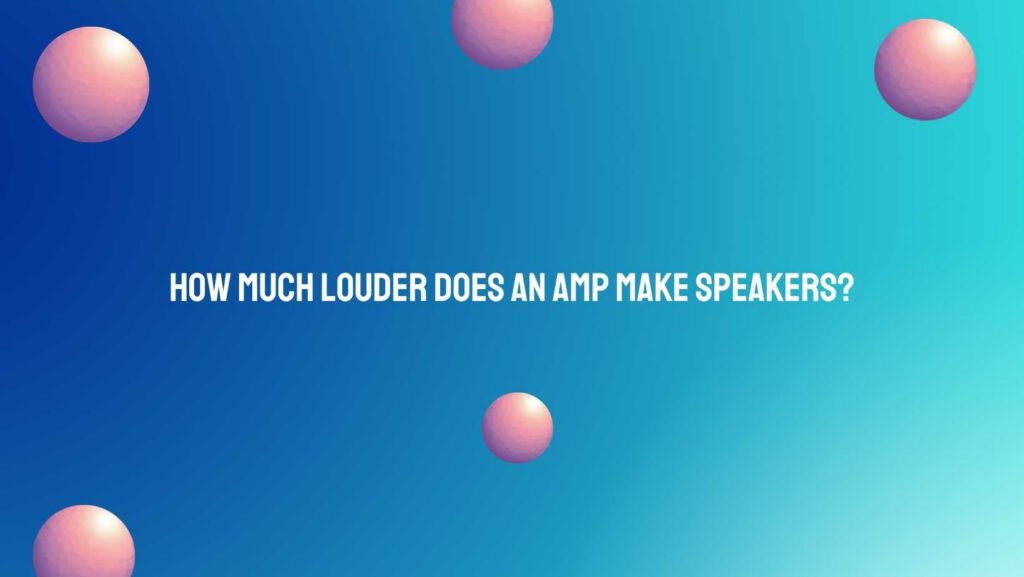When it comes to audio systems, the amplification of sound is essential. Amplifiers serve as the driving force behind speakers, allowing us to experience music, speech, and other auditory delights at varying levels of volume. But just how much louder does an amplifier make speakers? In this article, we’ll explore the decibel dynamics at play when amplifiers and speakers join forces, shedding light on the factors that influence the increase in volume and the relationship between amplifier power and perceived loudness.
Understanding Decibels
Before we dive into the specifics of how much an amplifier can boost the loudness of speakers, let’s establish a foundational understanding of decibels. Decibels (dB) are the unit of measurement used to quantify the intensity or amplitude of sound. The decibel scale is logarithmic, meaning that each increase of 10 dB represents a tenfold increase in sound intensity. This characteristic leads to some intriguing properties when it comes to sound amplification.
Amplifier Power and Speaker Loudness
The relationship between amplifier power and speaker loudness can be described by the following key points:
- Amplifier Power: The power rating of an amplifier, typically measured in watts (W), determines how much electrical energy it can provide to the speaker. A higher wattage amplifier can deliver more power to the speaker, which, in turn, can produce a louder sound.
- Doubling Power: One of the most crucial aspects of decibel dynamics is that doubling the amplifier’s power does not result in a doubling of perceived loudness. Instead, a doubling of power corresponds to an increase of about 3 dB in loudness. This is due to the logarithmic nature of the decibel scale.
- Speaker Sensitivity: The sensitivity of a speaker, often measured in decibels at 1 watt per 1 meter (dB SPL/W/m), is a significant factor in the equation. A more sensitive speaker will produce a higher sound level at the same amplifier power. For instance, a speaker with a sensitivity of 95 dB SPL/W/m will be louder than a speaker with a sensitivity of 90 dB SPL/W/m when driven by the same amplifier.
- Room Acoustics: The environment in which the speakers are placed also influences perceived loudness. The size and shape of the room, as well as factors like reflections and absorption, can affect the sound and how it is perceived.
Factors Affecting the Perceived Loudness
In addition to amplifier power and speaker sensitivity, several other factors can affect how much louder an amplifier makes speakers:
- Impedance Matching: The compatibility of the amplifier’s output impedance and the speaker’s input impedance is crucial for efficient power transfer.
- Distortion and Clipping: Excessive distortion or clipping in the amplifier can negatively impact sound quality and loudness, even if the amplifier has ample power.
- Equalization: The equalization settings used can boost specific frequency ranges, enhancing perceived loudness.
- Source Material: The quality and dynamics of the audio source, such as the recording or instrument, can also influence perceived loudness.
- Multiple Speakers: Using multiple speakers can distribute sound more effectively, potentially increasing perceived loudness.
The relationship between amplifier power and speaker loudness is complex, influenced by the power rating of the amplifier, the sensitivity of the speakers, and the characteristics of the audio environment. Understanding that a doubling of power results in an increase of about 3 dB in perceived loudness is a fundamental concept. However, several other factors can impact how much louder an amplifier makes speakers, including impedance matching, distortion, equalization, source material, and the use of multiple speakers.
In practice, achieving a significant increase in loudness may require a substantial increase in amplifier power, which can be limited by the speaker’s handling capacity. The optimal balance between amplifier power, speaker sensitivity, and room acoustics is the key to unlocking the full potential of an audio system and creating a rich and immersive auditory experience.


